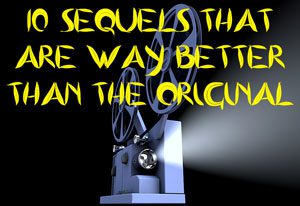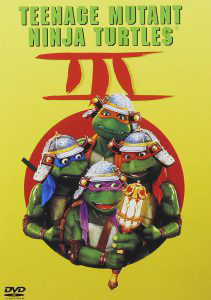“Teenage Mutant Ninja Turtles III” (1993) is so maligned by fans and non-fans alike that it’s possible that snarky blog and YouTube reviews are the only reason it gets re-watched at all. Certainly, I’m not here to defend this movie – obviously, it’s done on the cheap compared to the first two films, and it’s the only Turtles film that doesn’t stand up on the first viewing, let alone repeat viewings.
How bad is it?
The case I’ll attempt to make is this: Yes, “TMNT III” is bad, but it’s not completely without merit, and it might even be slightly better than “TMNT II: The Secret of the Ooze.” … In some ways. … If you kind of squint and look at it out of the corner of your eye.
On first viewing, “TMNT III” suffers much worse than the other three Turtles films, and that’s why it’s ranked last in the IMDB user ratings with a 4.7 (below the first movie’s 6.7, the fourth movie’s 6.4 and the second movie’s 5.9). In the theater, I remember cringing at Splinter’s new voice and being more aware than ever that he never moves (even though this is basically the case in the first two movies as well).

“Teenage Mutant Ninja Turtles III” (1993)
Director: Stuart Gillard
Writer: Stuart Gillard
Stars: Elias Koteas, Paige Turco, Stuart Wilson
When Walker falls into the water at the end and disappears before the splash sound effect, it jumped out at me as one of the worst special effects I’d ever seen in a movie that wasn’t straight-to-video.
In the opening sequence, when the Turtles practice martial arts to ZZ Top’s “Can’t Stop Rockin’, “ it struck me as lazy that they don’t punch and kick the credits off the screen as per the start of “TMNT II.” And I noticed that the Turtles’ mouth movements don’t sync up well in this movie, a result of Jim Henson Studios bowing out and the lesser-known (with good reason) All Effects Company taking the reins.
Although I approached it with an open mind, more flaws jumped out at me on my latest viewing. As the camera pans down the steps of the subway den to reveal the Turtles, the camera man is clearly walking; they couldn’t bother to use a Steadicam.
And many scenes run a beat too long, giving “TMNT III” a choppy, hard-to-get-comfortable pace. Note the Turtles’ departure from Japan interspersed with the Japanese soldiers’ departure from New York. Emotional scenes (Mike wanting to stay behind with Mitsu; one of the soldiers hugging Casey out of gratitude for showing him the future) are suddenly thrown into the mix, which is OK, but it takes forever.
Or consider the lead-up to Walker shooting a canon at Leo – it’s stagey, as is the Turtles’ rescue of Yoshi from the fire. Basically, every important scene is overblown, lessening the intended impact.

Moments of filmmaking laziness jump out at a viewer throughout. Don’s line “Who were you expecting – the Addams Family?” is fine for the trailer (“Addams Family Values” was a competing movie in ’93), but it shouldn’t be in the finished film.
If the Turtles are naked when they go through the time-tunnel, the Japanese warriors should be naked upon arrival in New York. I’m not saying I want to see that, but the fact that they’re wearing underwear doesn’t make logical sense. A simple fix would be to have all four Turtles – not just Mike – put on shorts before the time-tunneling.
Solid cast and stunts
All of this having been said, the top-billed Elias Koteas does return as Casey Jones while adding the role of Casey’s 1603 Japan lookalike, Whit. The cast of “TMNT III” is not too shabby. In fact, Paige Turco seems more comfortable as April this go-around.
And the fight choreographers and Turtle stunt performers are top-notch here — much better than in the second film, which is scared to show any violence, and maybe even better than the original. The Turtles’ voice work is also good – it’s nice to have Corey Feldman back as Don — if you can separate it from the animatronic issues.
What were Turco, Koteas and Feldman thinking when they signed on? Possibly, they just wanted a paycheck. But I also think it’s possible they read the script and rightly concluded that it’s meatier than “TMNT II.”
Removing their ‘Masks’
The central theme is that the Turtles don’t have to hide anymore; they can exist out in the open in ancient Japan. Initially, they are feared as “kappa” (demons), but once they prove themselves – when Mike and Leo save young Yoshi from a fire — they are not merely respected, but outright worshiped by the good guys.
In a nice parallel, the unnamed soldier who hugs Casey at the end really loves the 1993 Big Apple with its televised hockey games and Baltimora-blasting jukeboxes, and Whit – intrigued by April — wants to travel back to the future with her. Compare this to “Secret of the Ooze,” which is ostensibly about the Turtles’ mysterious origins, but really doesn’t have any thematic weight.
Writer-director Stuart Gillard – better at the former than the latter, judging by this sloppily shot and edited film – draws upon Mirage Volume 1, Issues 46-47 (“Masks”), where the Turtles go to ancient Japan via Renet and her scepter. Unfortunately, “TMNT III” cuts out Renet and all the cool time-travel ideas, such as Raphael accidentally creating the Foot Clan when he teaches ninja skills to samurai.
In the film, April just buys a scepter at a thrift store, and it’s never clear why the scepters activate. “TMNT III” also bears similarities to “Usagi Yojimbo” Volume 2, Issues 1-3 (“Shades of Green”), where the Turtles are magically whisked into the midst of a 17th century Japanese war.
In the “Usagi” arc, and in this movie, it’s not clear why the two sides are fighting, but that’s OK. In an early scene, Lord Norinaga’s son, Kenshin, rips his dad for this pointless war. Later, in the film’s most poignant scene, Raph tells Yoshi to gather up his friends and go play in the mountains when the shooting starts tomorrow.
It’s not clear how in the world Norinaga has a tapestry chronicling the fact that four mutant ninja turtles menaced his ancestors, but at least it raises intriguing questions. Will the Turtles go back to the past in another story? Is the movie saying something about how history repeats itself (see also the similar look of Casey and Whit, and April noting that a rat “looks familiar”)? All told, “TMNT III’s” script has more going for it than the second movie.
Sloppy editing and direction
But this is only on the page. The execution is a step down from the outstanding first movie and slick second movie. The biggest flaw is that “TMNT III” isn’t tightly edited; the problems are enhanced rather than hidden. For example, in his review of the movie, the Angry Video Game Nerd shows how the sloppy Walker-jumping-into-the-water special effect could be salvaged by a judicious edit.
Gillard’s direction is flawed, too. If the Turtles’ ancient Japanese adventure were played mostly straight – with a third as many quips – and interspersed more evenly with the funny scenes of Casey teaching the warriors about hockey and video games – the movie’s theme of displacement would land better.
I also get a sense that Norinaga and Walker are seriously handcuffed as villains; while the actors are fine (again, the loose editing does them no favors), the characters don’t get to actually be evil, they’re only allowed to talk evil.
Almost everyone was disappointed by this movie, and while its mediocrity may or may not be to blame, the franchise went into a deep slumber afterward. The next movie wouldn’t come out until 14 years later, and it doesn’t even have live-action Turtles in it. And now, in 2014, we’re getting live-action Turtles again, but in a reboot that doesn’t look or feel right.
“TMNT III” will always be a film that could’ve been better if only this, and if only that. But at the same time, most people don’t really care enough about this movie to wish it to be better.
Heck, even the marketers couldn’t come up with a subtitle (although at least the “III” is in Japanese script); I sometimes think it’s called “The Turtles are Back … in Time,” but I guess that’s just a tagline. The DVD four-pack labels it “TMNT III: Turtles in Time,” mixing it up with a video-game title.
Yeah, it can be argued that it’s better than “TMNT II” on paper, but ultimately, I suppose there’s a reason why everyone remembers “Ninja Rap” while “TMNT III” is just “that really bad third movie.”

